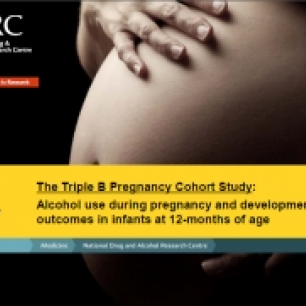This is a copy of the presentation made by Dr Delyse Hutchinson at the 2015 NDARC Annual Research Symposium in Session Two.
Background: Heavy alcohol use and abuse in pregnancy are linked with developmental problems in offspring. However, less is understood in relation to the impacts of low-level alcohol exposure on infant developmental outcomes. In part, this is due a lack of high quality epidemiological data and in-depth measurement (i.e., clinical and observational data) on early development.
Aims: This presentation will use data from the Triple B Pregnancy Cohort Study to: (a) describe the patterns and prevalence of maternal alcohol use across the three trimesters of pregnancy, and (b) examine the impacts on infant development.
Design and methods: The cohort has data on alcohol exposures at each trimester of pregnancy (trimesters one, two and three) and at three waves across the first year (birth, 8-weeks and 12-months postpartum). Data on infant cognitive, language, motor and socio-emotional development were collected at 12-months using the Bayley Scales of Infant Development (BSID). The sample consists of over 1,600 participants recruited in 2009-13 from antenatal clinics in NSW and WA.
Results: Results will describe the patterns and prevalence of maternal drinking behaviours across the three trimesters of pregnancy. They will address unanswered questions about the differential effects of the timing of exposure (i.e., alcohol exposure harms may vary at different trimesters); and stability of exposure (i.e., regular and single occasion drinking are likely to be associated with different harms) on offspring development. Risk relationships will be examined using multivariate regression methods, controlling for potential confounding factors (e.g., infant gender, parent socio-economic status, other drug use, mental health).
Implications: This research will improve knowledge of the patterns and prevalence of alcohol use among pregnant women and, in particular, how alcohol exposure impacts on offspring development in infancy. This will result in new knowledge relevant to service delivery and policy development in Australia and to parents, families and children directly.


